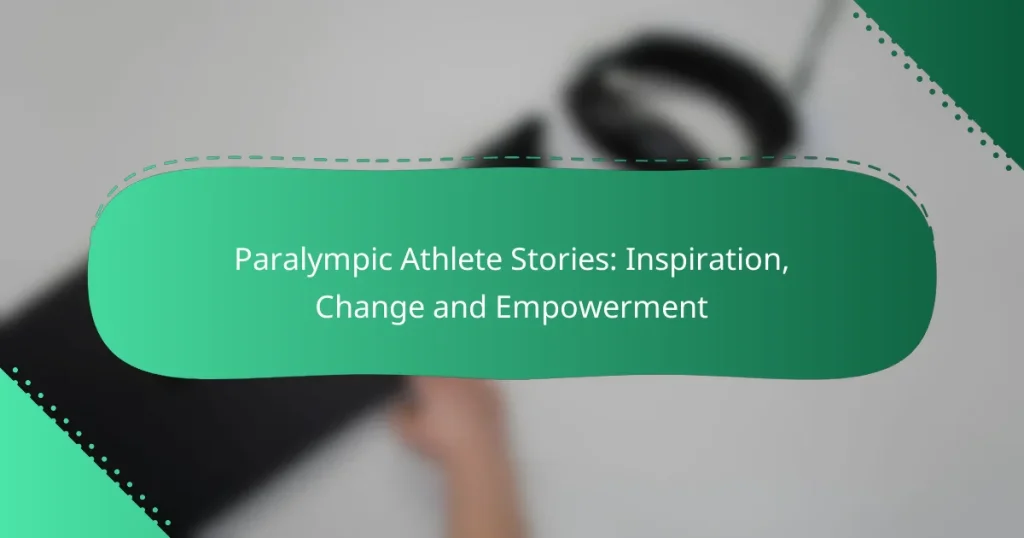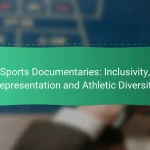Paralympic athletes embody resilience and determination, inspiring change by challenging societal perceptions of disability. Their remarkable journeys highlight the power of perseverance and the importance of inclusivity, motivating others to overcome obstacles and strive for excellence in sports and life.

How Do Paralympic Athletes Inspire Change?
Paralympic athletes inspire change by showcasing resilience and determination, challenging societal norms about disability. Their achievements not only motivate individuals but also drive conversations around inclusivity and accessibility in sports and beyond.
Personal stories of resilience
Each Paralympic athlete has a unique journey marked by personal challenges and triumphs. For instance, many have overcome significant physical obstacles, such as amputations or paralysis, to excel in their respective sports. These narratives often highlight the athletes’ mental fortitude and commitment to their goals.
Stories like that of Tatyana McFadden, who overcame childhood adversity to become a world-class wheelchair racer, illustrate the power of perseverance. Such experiences resonate widely, encouraging others facing difficulties to pursue their passions regardless of setbacks.
Impact on societal perceptions
Paralympic athletes play a crucial role in reshaping how society views disability. Their visibility in high-profile competitions helps to break down stereotypes and misconceptions, fostering a more inclusive mindset. As they achieve remarkable feats, they challenge the narrative that limits individuals with disabilities to certain roles.
For example, media coverage of the Paralympics often highlights not just the athletes’ disabilities but their skills and achievements, promoting a broader understanding of what is possible. This shift in perception can lead to increased support for accessibility initiatives and disability rights.
Role in advocacy for disability rights
Many Paralympic athletes actively engage in advocacy for disability rights, using their platforms to promote equality and accessibility. They often collaborate with organizations to push for policy changes that benefit individuals with disabilities, such as improved facilities and funding for adaptive sports.
For instance, athletes like Ellie Simmonds have campaigned for better representation and resources for disabled individuals in sports. Their advocacy not only raises awareness but also inspires systemic changes that enhance the lives of many beyond the athletic arena.

What Are Notable Paralympic Athlete Stories?
Notable Paralympic athlete stories highlight the journeys of individuals who have overcome significant challenges to achieve excellence in sports. These narratives inspire change and empowerment, showcasing resilience and determination in the face of adversity.
Beatrice Vio’s journey
Beatrice Vio, an Italian fencer, is renowned for her remarkable comeback after losing her legs to meningitis at a young age. She began fencing at the age of 12 and quickly rose to prominence, winning multiple gold medals at the Paralympic Games.
Her story emphasizes the importance of passion and perseverance. Vio’s determination not only earned her accolades but also made her a symbol of hope for many facing similar challenges.
David Brown’s achievements
David Brown, an American sprinter, made history as the first visually impaired athlete to run 100 meters in under 11 seconds. His achievements include multiple gold medals at the Paralympic Games and World Championships, showcasing his speed and skill.
Brown’s success is a testament to the power of adaptive sports. He has inspired countless athletes with disabilities to pursue their dreams, proving that limitations can be overcome with hard work and dedication.
Jessica Long’s impact
Jessica Long, a U.S. swimmer, is celebrated for her incredible achievements, including winning over 20 medals at the Paralympic Games. Born with a congenital limb deficiency, she has become a role model for young athletes worldwide.
Long’s impact extends beyond her athletic success; she actively advocates for disability awareness and inclusion in sports. Her story encourages others to embrace their differences and strive for greatness, regardless of their circumstances.

How Do Paralympic Athletes Overcome Challenges?
Paralympic athletes overcome challenges through tailored training, mental resilience, and strong support networks. These elements work together to help athletes navigate their unique obstacles and achieve their goals in sports.
Training adaptations
Training adaptations for Paralympic athletes often involve modifying techniques and equipment to suit individual needs. For instance, wheelchair athletes may use specialized chairs designed for speed and maneuverability, while visually impaired athletes might train with guides to enhance their performance.
Additionally, coaches often develop personalized training regimens that focus on the athlete’s strengths and limitations. This can include varying workout intensity and duration to accommodate different physical abilities and recovery times.
Mental health strategies
Mental health strategies are crucial for Paralympic athletes to maintain focus and motivation. Techniques such as visualization, mindfulness, and positive self-talk can help athletes manage stress and anxiety during competitions.
Regular mental health check-ins and access to sports psychologists can also provide essential support. Athletes are encouraged to develop coping mechanisms to deal with setbacks and maintain a positive outlook on their journey.
Support systems in sports
Support systems play a vital role in the success of Paralympic athletes. Family, friends, coaches, and fellow athletes contribute to a strong network that fosters encouragement and motivation. These relationships can help athletes navigate the emotional and physical challenges they face.
Moreover, organizations dedicated to adaptive sports often provide resources, funding, and training opportunities. Engaging with these communities can enhance an athlete’s experience and open doors to new possibilities in their sporting careers.

What Digital Products Support Paralympic Athletes?
Digital products play a crucial role in supporting Paralympic athletes by enhancing training, providing motivation, and improving access to specialized equipment. These tools can help athletes optimize their performance and achieve their goals through tailored solutions.
Online coaching platforms
Online coaching platforms offer personalized training programs and expert guidance for Paralympic athletes. These platforms typically connect athletes with certified coaches who understand adaptive sports and can tailor workouts to individual needs.
When choosing an online coaching platform, consider factors such as the coach’s experience with adaptive sports, the platform’s user interface, and the availability of video analysis tools. Popular platforms may charge monthly fees ranging from $50 to $200, depending on the level of service.
Adaptive sports equipment
Adaptive sports equipment is essential for enabling Paralympic athletes to compete effectively. This includes specialized wheelchairs, prosthetics, and other gear designed to accommodate various disabilities.
Investing in the right adaptive equipment can significantly impact performance. Athletes should research options that meet their specific needs, considering factors like weight, durability, and adjustability. Prices for adaptive sports equipment can vary widely, often ranging from a few hundred to several thousand dollars.
Motivational apps
Motivational apps can help Paralympic athletes stay focused and inspired throughout their training journey. These apps often include features like goal setting, progress tracking, and community support to foster a sense of belonging.
When selecting a motivational app, look for user-friendly interfaces and features that resonate with personal goals. Some popular options may offer free versions with basic features, while premium versions can range from $5 to $30 per month, depending on the app’s capabilities.

How Can You Get Involved with Paralympic Sports?
Getting involved with Paralympic sports can be rewarding and impactful, whether through volunteering, participating in local programs, or fundraising. Each avenue offers unique opportunities to support athletes and promote inclusivity in sports.
Volunteering opportunities
Volunteering is a vital way to support Paralympic sports. Organizations often seek volunteers for events, coaching, and administrative roles. You can find opportunities through local sports clubs, national Paralympic committees, or non-profit organizations dedicated to adaptive sports.
Consider reaching out to local events or checking online platforms that list volunteer positions. Many roles require minimal commitment, allowing you to contribute your time and skills while gaining valuable experience in the adaptive sports community.
Local adaptive sports programs
Local adaptive sports programs provide opportunities for individuals with disabilities to participate in various sports. These programs often cater to different skill levels and ages, ensuring inclusivity and accessibility. Look for community centers, schools, or specialized organizations that offer adaptive sports activities.
Joining a local program can enhance physical fitness and build social connections. Many cities have established leagues or clubs for sports like wheelchair basketball, adaptive cycling, or swimming, making it easier to find a suitable program nearby.
Fundraising for athletes
Fundraising is essential for supporting Paralympic athletes in their training and competition expenses. You can organize events, create online campaigns, or partner with local businesses to raise funds. Consider using platforms like GoFundMe or Kickstarter to reach a wider audience.
When planning a fundraising initiative, set clear goals and communicate the impact of donations. Engaging your community through events like charity runs or auctions can also raise awareness about adaptive sports while generating financial support for athletes.

What Are the Future Trends in Paralympic Sports?
The future of Paralympic sports is shaped by advancements in technology, increased inclusivity, and growing global awareness. These trends are driving innovation in training, competition, and athlete support, ultimately enhancing performance and participation.
Technological advancements in training
Technological innovations are revolutionizing training methods for Paralympic athletes. Tools such as virtual reality (VR) and artificial intelligence (AI) are being integrated into training regimens, allowing athletes to simulate competition scenarios and receive personalized feedback on their performance.
Wearable technology, including smart sensors and fitness trackers, provides real-time data on an athlete’s physical condition, helping coaches tailor training programs to individual needs. This data-driven approach can lead to improved outcomes, as athletes can monitor their progress and adjust their routines accordingly.
As technology continues to evolve, athletes can expect even more sophisticated training tools. For instance, advancements in biomechanics may lead to better prosthetics and adaptive equipment, enhancing performance and enabling athletes to push their limits further than ever before.


